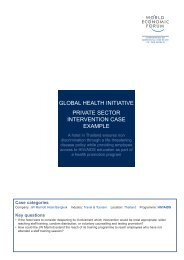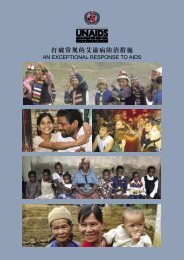X HIV/AIDS Prevention and Care in Resource-Constrained Settings
X HIV/AIDS Prevention and Care in Resource-Constrained Settings
X HIV/AIDS Prevention and Care in Resource-Constrained Settings
- No tags were found...
You also want an ePaper? Increase the reach of your titles
YUMPU automatically turns print PDFs into web optimized ePapers that Google loves.
F igure 1Factors That InfluenceThe Spread of <strong>HIV</strong>Viral Factors■ <strong>HIV</strong>-1 stra<strong>in</strong>s■ ViremiaLocal Genital Factors■ Presence of STDs■ Male cicumcision■ Use of vag<strong>in</strong>al productsSexual Behavior■ Rate of partner exchange■ Sexual mix<strong>in</strong>g patterns■ Type of <strong>in</strong>tercourse■ Size <strong>and</strong> rate of contact with core groups■ Level of condom useDemographic Factors■ Percentage of sexually active age groups toother age groups■ Male to female ratio■ Urban: rural percentage■ Migration patternsEconomic <strong>and</strong> Political Factors■ Level of poverty■ War <strong>and</strong> social conflicts■ Status of transport <strong>and</strong> mobility of population■ Performance of health care system■ Response to epidemic(from Piot-1994)STATUS AND TRENDS OFTHE <strong>HIV</strong>/<strong>AIDS</strong> EPIDEMICSAlthough the <strong>AIDS</strong> p<strong>and</strong>emic is complex, track<strong>in</strong>g<strong>and</strong> analyz<strong>in</strong>g its evolution <strong>and</strong> diversity enables us to<strong>in</strong>tervene more effectively <strong>and</strong> to more accuratelypredict future trends. We assumed <strong>in</strong> the late 1980sthat any country with evidence of widespread riskconditions for <strong>HIV</strong> transmission would <strong>in</strong>evitablysuffer an extensive epidemic once <strong>HIV</strong> was <strong>in</strong>troduced<strong>in</strong>to the population. This “evidence” of risk behaviors<strong>in</strong>cluded the presence of a commercial sex <strong>in</strong>dustry,high background prevalence of other sexually transmitteddiseases (STDs) <strong>in</strong> the population, low condomuse by men <strong>and</strong> the existence of <strong>in</strong>jection druguse (IDU). But this was a far too simplistic view of theunderly<strong>in</strong>g dynamics of the p<strong>and</strong>emic. In Asia, forexample, we have seen the epidemic explode <strong>in</strong>Cambodia, Burma, Thail<strong>and</strong> <strong>and</strong> <strong>in</strong> some states ofIndia, yet rema<strong>in</strong> very concentrated <strong>and</strong> <strong>in</strong> low prevalence<strong>in</strong> the Philipp<strong>in</strong>es <strong>and</strong> Indonesia.The p<strong>and</strong>emic cont<strong>in</strong>ues to defy simple models<strong>and</strong> formulas. We now recognize that there are anumber of host, viral <strong>and</strong> social factors that determ<strong>in</strong>etransmission <strong>and</strong> vulnerability. These <strong>in</strong>teract <strong>in</strong> acomplex manner <strong>in</strong> the mosaic of global sett<strong>in</strong>gs.Figure 1 lists the most predom<strong>in</strong>ant determ<strong>in</strong>ants.It has become <strong>in</strong>creas<strong>in</strong>gly important to <strong>in</strong>tegrateimproved biological surveillance data with detailed<strong>in</strong>formation about the social <strong>and</strong> economic patternsthat lead to <strong>in</strong>creased risk behaviors <strong>and</strong> vulnerability.These “second generation” surveillance systems willimprove our ability to describe the state of local epidemics<strong>and</strong> target our <strong>in</strong>terventions for the future. Butit is challeng<strong>in</strong>g to collect this range <strong>and</strong> depth of datafor each country. Among this array of determ<strong>in</strong>ants,there are a number of predom<strong>in</strong>ant factors. Sexualbehaviors <strong>and</strong> the pattern of sexual networks areclearly the most important factors <strong>in</strong> the most severesexually transmitted epidemics. We have recentlylearned that subtle quantitative differences <strong>in</strong> behaviorcan either cause the epidemic to explode or stabilize ata relatively low level of prevalence. It is not a matterof whether commercial or casual sex exists <strong>in</strong> a society,but how much, of what k<strong>in</strong>ds, when it is practiced<strong>and</strong> by whom.Besides risk behavior patterns, there are <strong>in</strong>creas<strong>in</strong>gdata on the possible role of STDs, <strong>HIV</strong>-1 subtypes<strong>and</strong> male circumcision <strong>in</strong> the efficiency of variousVIII <strong>HIV</strong>/<strong>AIDS</strong> <strong>Prevention</strong> <strong>and</strong> <strong>Care</strong> <strong>in</strong> <strong>Resource</strong>-Constra<strong>in</strong>ed Sett<strong>in</strong>gs
















